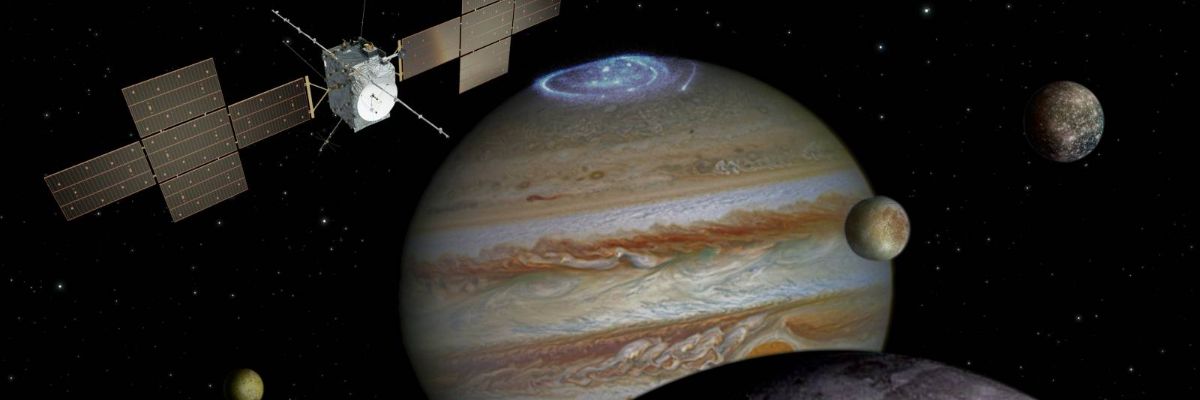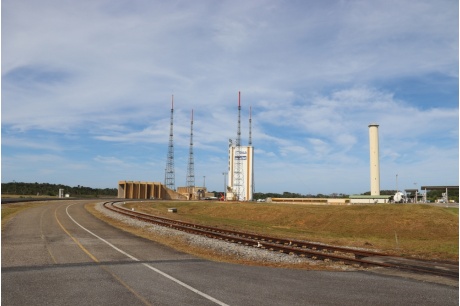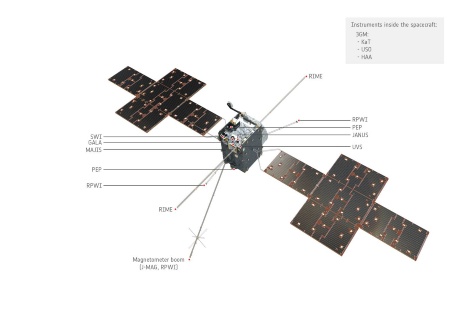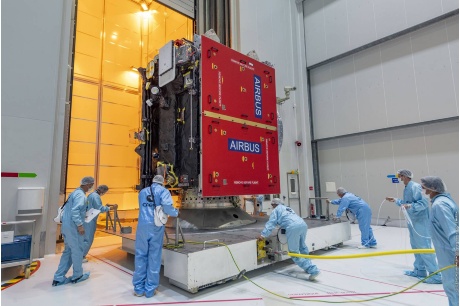
Czech traces in space: the JUICE spacecraft’s odyssey to the moons of Jupiter
21. 04. 2023
On 14 April 2023 at 12:14 PM (UTC), the Jupiter Icy Moons Explorer (JUICE), a giant interplanetary probe, embarked on its eight-year odyssey. The journey to the planet Jupiter has a clear goal – to explore its icy moons. The first of the major projects of the European Space Agency’s Cosmic Vision programme also involves the Czech Academy of Sciences, namely its Institute of Atmospheric Physics and the Astronomical Institute.
What did the lead-up to the launch look like? A few days prior to the launch, final preparations at the Guiana Space Centre (also called Europe’s Spaceport) in French Guiana included having tanks of the JUICE interplanetary probe already full of oxygenator and methylhydrazine rocket fuel. The probe was mounted on the tip of the Ariane 5 rocket and covered with an aerodynamic shield for the first stages of the flight. One day before lift-off, technicians slid the rocket from the final assembly building (Bâtiment d’Assemblage Final or BAF) onto the launch pad.
Due to technical problems, the spacecraft was launched one day later than planned. Whenever technical or weather-related issues arise, an extended launch window of 14 days can be used. Otherwise, in this case, the next opportunity to launch would have occurred in four months.

JUICE will embark on its eight-year voyage from the Guiana Space Centre and travel nearly a billion kilometres.
Thirty minutes after lift-off, the spacecraft separated from the launch vehicle and then unfurled large solar panels, made up of 10 segments with a total area of 85 square metres. These provide power for scientific equipment and service systems. Gradually, the arms unfolded with the other sensors, antennas, and magnetometers, and JUICE then embarked on its nearly one-billion-kilometre journey to Jupiter.
During its odyssey, it will undergo several gravity assist manoeuvres: back around Earth and the Moon in August 2024, Venus in August 2025, and Earth again in September 2026. The final gravitational slingshot around Earth in January 2029 will send it straight to Jupiter, where it should arrive in July 2031.
The spacecraft itself weighs 2.4 tonnes and will carry a 3.6-tonne supply of fuel needed for the successive gravity assist manoeuvres around Earth, the Moon, and Venus and for getting the probe into the orbit of Jupiter and its moon Ganymede.
Eight years of travel and four years of research
The main task of the mission is to explore Jupiter and its icy moons, with a particular focus on Ganymede, one of Jupiter’s Galilean moons. JUICE will be orbiting Jupiter and collecting scientific data until December 2034. After being guided into orbit around Ganymede, it will study it in detail and conclude its mission after four years of research at the end of 2035 by impacting the surface of the largest moon in the Solar System.

The JUICE interplanetary probe is equipped with 85 m2 of solar panels and will carry ten scientific instruments.
JUICE will carry a dozen scientific instruments: optical cameras, spectrometers, an altimeter, radar, particle detectors, and electric and magnetic field sensors. These will all come into play in the exploration of Jupiter and its moons, which hide oceans of liquid water beneath their icy surface. Experts believe the oceans could hold good conditions for life.
“We also know from previous Galileo probe measurements that the moon Ganymede has its own magnetic field, in which electromagnetic waves propagate at audible frequencies. We don’t know much about them or similar phenomena in Jupiter’s magnetosphere, although they could be very important for the radiation levels around the planet,” says Ondřej Santolík, head of the Czech research team from the Institute of Atmospheric Physics of the CAS.

Technicians preparing the launch of the JUICE spacecraft. It was carried into space by an Ariane 5 rocket.
The mystery of electromagnetic waves
Electromagnetic waves will be the focus of a new instrument, the development and construction of which was led by the Swedish Institute of Space Physics in Uppsala, with the cooperation of 25 institutions from nine countries. The measurements at audible frequencies were prepared by researchers and technicians from the Department of Space Physics of the Institute of Atmospheric Physics of the CAS in collaboration with colleagues from the Astronomical Institute of the CAS, who built the power supply for the instrument.
“Previous probes weren’t able to detect where the waves are propagating from. This new instrument on the JUICE probe will allow us to do this by measuring multiple components of the electric and magnetic fields. These will be automatically analysed immediately on board the spacecraft,” Santolík explains.
“A week after the launch, we will be working intensively on the controlled tilting of the measuring antennas. During the flight to Jupiter, we plan to use our instrument to detect the impact of cosmic dust on the probe, contributing thus to researching its presence especially in the asteroid belt between Mars and Jupiter,” he adds.
The Czech researchers will also work on completing the development of new versions of the on-board data processing software, testing them and sending them to the spacecraft in several stages during the planned gravity manoeuvres around Earth. This all under the umbrella of the CAS Strategy AV21 research programme Space for Mankind, which focuses on the development and testing of new technologies for space research and includes the involvement of Czech scientists in the large X-ray observatory Athena, the mission to the icy moons of the Jupiter (JUICE), measurements on the Moon surface, preparation of the X-ray polarimetry mission XIPE, the project of the European space mission to the Sun (Solar Orbiter), the development of high-technology opto-mechanical systems for satellites, and space research of lightning in the upper layers of the Earth atmosphere.
Prepared by: Markéta Wernerová, Division of External Relations, CAO of the CAS, with use of the CAS press release
Translated by: Tereza Novická, Division of External Relations, CAO of the CAS
Photo: ESA; Shutterstock
 The text is released for use under a Creative Commons licence.
The text is released for use under a Creative Commons licence.
Read also
- Public Hearing: “Making Sense of Open Science”
- SUNER-C concludes after three years dedicated to the renewable energy future
- A trapped state: The pandemic impact on public attitudes, trust, and behavior
- Aerial archaeology: Tracing the footsteps of our ancestors from the sky
- Archaeologists uncover ancient finds along Prague Ring Road
- Our microbiome largely depends on what we eat, says microbiologist Michal Kraus
- The ABCs of writing: Why did its invention mark a turning point for humankind?
- We learn, remember, forget… What can memory actually do? And can we outsmart it?
- New Center for Electron Microscopy in Brno opens its doors to global science
- The hidden lives of waste: What can we learn from waste workers and pickers?
The Czech Academy of Sciences (the CAS)
The mission of the CAS
The primary mission of the CAS is to conduct research in a broad spectrum of natural, technical and social sciences as well as humanities. This research aims to advance progress of scientific knowledge at the international level, considering, however, the specific needs of the Czech society and the national culture.
President of the CAS
Prof. Eva Zažímalová has started her second term of office in May 2021. She is a respected scientist, and a Professor of Plant Anatomy and Physiology.
She is also a part of GCSA of the EU.